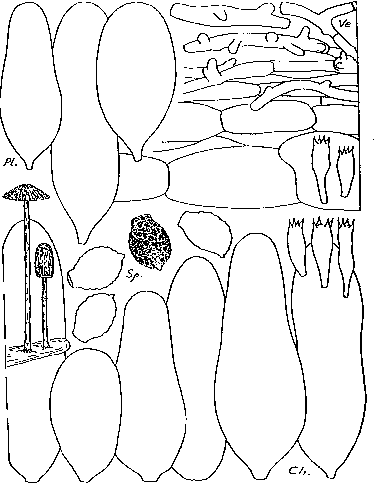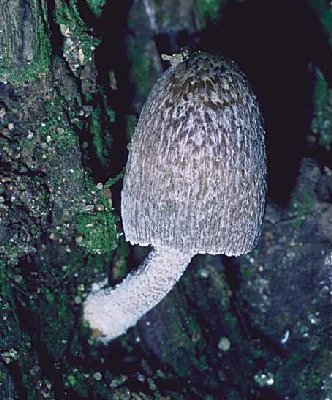Macroscopic features |
Pileus 10-20 x 5-10 mm when still closed, ellipsoid or ovoid, 10-30 mm when expanded, first white, soon becoming greyish; centre very dark under veil. Veil white to grey, radially splitting up in minute, hairy-fibrillose scales. Lamellae, L = 18-42, l = 0-3, rather crowded, free, first white, then greyish, finally blackish. Stipe up to 100 x 1-3 mm, whitish; base slightly clavate, up to 4 mm wide. |
Microscopic features |
Spores [140,7,6] 8.5-12(-13) x 6.1-8.2 µm, amygdaliform with warty ornamentation, truncate, very dark red-brown in most cases, with central, 1.5-1.8 µm wide germ pore; Q = 1.25-1.80, av. Q = 1.35-1.60; av. L = 9.2-11.1, av. B = 6.8-7.4 µm. Basidia 16-38 x 8-9.5 µm, 4-spored, surrounded by 3-6(-7) pseudoparaphyses. Pleurocystidia 60-120(-150) x 20-50(-80) µm, ellipsoid, oblong, utriform or (sub)cylindrical. Cheilocystidia 25-100 x 20-55 µm, subglobose, ellipsoid, utriform or (sub)cylindrical. Elements of veil thin-walled, diverticulate, 2-8 µm thick. Clamp-connections present. |
Habitat & distribution |
In small groups on wood. Widespread but not common in Europe. |
Remarks |
Coprinus echinosporus is easily recognized by the warty, amygdaliform spores and the 4-spored basidia. The spores of C. phlyctidosporus and C. rugosobisporus, two species close to C. echinosporus, are ovoid. |

[Copyright © by Uljé]

[Copyright © by Hans Bender jbe8995374@aol.com]